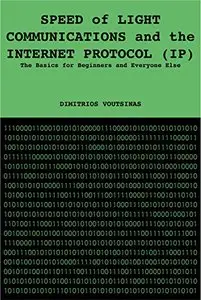Speed of Light Communications and the Internet Protocol (IP) by Dimitrios Voutsinas
English | Mar 7, 2015 | ASIN: B00UEOO1T8 | 221 Pages | AZW3/EPUB/PDF (conv) | 19 MB
English | Mar 7, 2015 | ASIN: B00UEOO1T8 | 221 Pages | AZW3/EPUB/PDF (conv) | 19 MB
We often take the global network infrastructure and communications protocols that underpin the Internet, and everything else that enables digital communications for granted. How does an email, video or voice call transcend from a screen onto wires to arrive, at the speed-of-light, in a different part of the world? An email sent from London to Sydney takes roughly 70 milliseconds (ms) to reach the receiving end user. This is less than a tenth of a second! That is quite extraordinary! How does data, voice, video and photos transcend from our phone, computer or tablet and into ones and zeros across underground and undersea cables to reach our intended recipients?
This eBook started out as a five-day network communications course, and was developed during the late 1990s to early 2000s when the proliferation of the Internet started to gain momentum. There was a growing demand for individuals with network and Internet Protocol (IP) experience and as a consequence, there was an increasing demand for educational material. The original training course has been adapted into an eBook. This eBook contains the culmination of 20 years network communications and Internet field experience as well as lecture and personal notes.
The training course material and notes have been updated and converted into an easy to follow eBook that can help everyone understand the very basics of network communications and the Internet Protocol (IP). IP is the protocol that underpins the Internet of everything. This eBook can be used as a general reference or to learn more about specific network communications areas of interest. It is specifically aimed at the novice school student and aspiring network architect, designer and engineer of the future. In fact, it is aimed to anyone that is perhaps a little curious about how information travels at the speed-of-light, from one corner of the earth to another, to help us communicate and share experiences and ideas with one another.
As we reflect on how the communications industry has evolved over the last 30 years, it is quite clear that the underlying network communications protocols used today to transport megabytes, gigabytes, terabytes and petabytes of data, are fundamentally the same as those used almost 30 years ago. What has changed is the capacity of the underlying physical infrastructure required to move quadrillions of bits (ones and zeros) around the world and as a consequence of our insatiable demand for more data and bandwidth.
Network communications and as a consequence, the Internet, is perhaps one of the greatest technological revolutions of the twenty first century. It has had a profound impact on every aspect of our life. And we have all benefited immensely from this extraordinary discovery. As the Internet evolves and innovation continues, we are perhaps now in the midst of another great technological revolution – an Artificial Intelligence (AI), mobile and cloud based one.



